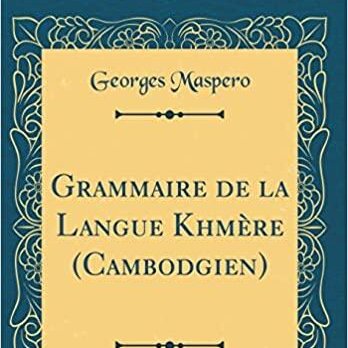Le Royaume de Champa | The Kingdom of Champa
by Georges Maspero
Mainly based on Chinese sources and local inscriptions, the formidable study on the Kingdom of Champa and what it tells us about Angkor

Type: on-demand books
Publisher: in T'oung Pao Journal, serialized publication from March 1910 to April 1911
Edition: ADB Document from Internet Archive depository
Published: 1910
Author: Georges Maspero
Pages: 311
Languages : French, Chinese
Right after completing his monumental work on the Khmer Empire (L'empire khmer), the sinologist and sanskritist Georges Maspero -- who then was also Administrateur des Services Civils de l'Indo-Chine (General Administrator of Indochina Public Services) -- turned his attention and copious energy to the Kingdom of Champa, a prosperous and often belligerant neighbor of Cambodia until its collapse (in 1470, according to the author, in 1471 according to more recent studies).
Drawing from Chinese and Khmer sources, as well as from Franciscan friar Odoric of Pordenone who visited the region in the 14th century, the author gives us a vivid portrait of the Kingdom of Champa, its dynastic successsion, its historic correlation with the Malay Peninsula and Java, its ongoing frictions with the Annamite (Dai Viet) sovereigns and with the Khmer Empire, and its arts.
The author did a pioneering working in clarifying some controversed points of history, including:
- Indrapura as the capital city of Champa's Indravarman II (10th century): 'Haradevi, his widow describes in an inscription found at the Dong Duong site "la ville parée de la splendeur d'Indra, brillante de lotus blancs, ornée des plus belles fleurs de lotus, fondée par Bhrgu [one of the mythical divine emissaries with Uroja, founders of Champa] dans les temps anciens, cette ville appelée Campa". At the time of Indravarman II, states the author, "le Champa n'avait point d'ennemi. Au Cambodge, Jayavarman II, d'abord, qui s'éteignit en 869, après un règne de soixante sept ans, puis Jayavarman III, Indravarman I, enfin, le premier des grands bâtisseurs d'Angkor, qui mourut en 889, étaient plus occupés à assurer la paix chez eux qu'à porter leurs armes au dehors.'
- Islam as a late addition to the Cham civilization, mostly developing among the Cham diaspora after the collapse of Champa: "Nulle inscription, nul texte authentique ne dit explicitement ou ne laisse même sous entendre que la religion de Mahomet ait été pratiquée au royaume de Champa avant l'année 1470 qui marque sa chute. Une remarque s'impose d'ailleurs: les deux tiers des Chams vivant actuellement au Champa pratiquent encore le brahmanisme, alors que la totalité de ceux qui ont quitté la patrie pour aller s'installer au Cambodge sont devenus musulmans; il est donc à se demander si ces expatriés n'ont pas été convertis à l'islamisme depuis leur exil seulement, par les Malais, leurs parents, établis dans le pays Khmèr, et si ce n'est pas eux qui ont, par esprit de propagande, essayé de convertir à leur tour leurs frères restés au pays, tentative qui n'aurait eu que peu de succès puisqu'un tiers seulement de ces derniers aurait embrassé la nouvelle foi.' (1)
- The prevalence of Malay and Javanese myths in Champa culture: quoting Odoric de Pordenone (in the Old French version of his travel relation), the author gives the example of a fish-related legend popular during the reign of King Che A-Nan, who defeated Annam King Ninh Hoang in 1326: 'Près de l'isle Natem, est un royaume qui a nom Campe [Champa] et y a très bel pays, car on y treuve toutes manières de vivres à très grant habondance de biens. Le roy qui en ce pays regnoit quant je y fus, avait bien CC [two hundreds] enfants, que fieux que filles: car il avoit pluseurs femmes espousées et grant planté de concubines (...) En ce pays treuve on grande merveille: car toutes manières de poisson que on treuve en la mer vient en ce pays si que on ne vois riens en cette mer fors que poisson. Et vient chascune espèce de poisson par lui, et demeure trois jours droit à la rive, et puis s'en va cette manière de poisson. Puis vient une autre generaction et fait ce meismes et sic de aliis jusques à tant que tous y sont venus une fois on en l'an tant seulement. Et quant on demande à ceulx du pays dont ce vient et que ce monte, ilz dient que ces poissons viennent faire reverence au roy de ce pays.'
(1) About the Brahmanism-Muslim syncretism of the Bani Chams in modern Vietnam, watch this 2006 documentary.
Tags: Chinese sources, Champa, Indravarman VI, Chenla, Khmer Empire, Chams, Cham civilization, Indravarman II, Dai Viet, Java, Malay, epigraphy, Khmer inscriptions, Cham inscriptions
About the Author

Georges Maspero
René Gaston Georges Maspero (21 August 1872 – 21 September 1942) was a French sinologist and a civil officer with the French Protectorate in Cambodia.
He was the son of egyptologist Gaston Maspero and half-brother of sinologist Henri Maspero.
A colonial governor of French Indochina, he was appointed Resident-Mayor of Haiphong, then acting Resident Superior (15 April 1920 – 6 December 1920) of Cambodia. He was among the founders of the École française d'Extrême-Orient (EFEO).
His daughter, Eveline Porée-Maspero, has extensively studied Khmer culture and Cambodian mores. She wrote his obituary in EFEO Bulletin, here.
